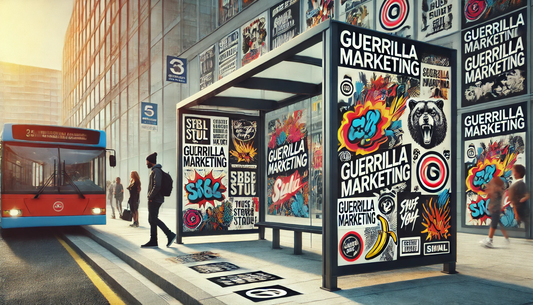🎨🌆 Introduction to Ambient Marketing 📣✨
Ambient Marketing is a unique approach that integrates advertising into everyday environments, subtly surrounding people with a brand's message in unexpected ways 🌐.
This strategy is particularly valuable for startups with limited budgets because it leverages creative placements rather than expensive media buys 🎟️.
By blending into public spaces or daily routines, startups can engage audiences without the traditional pressure of advertising, creating memorable connections without breaking the bank 🏦💡.
💥🌟 Top 10 Real-Life Examples of Ambient Marketing Success 🌟💥
- 🍔 McDonald's “Fresh Salads” Bus Shelter: McDonald’s transformed bus shelters into fresh gardens, highlighting the freshness of their salads 🥗.
- 🎉 Coca-Cola “Happiness Machines”: Coca-Cola installed vending machines that surprised customers with free items, sparking joy and creating viral moments 💖.
- 🛋️ IKEA’s Paris Bus Stop Living Rooms: IKEA turned bus stops into mini living rooms, inviting people to experience their furniture in an everyday setting 🏠.
- 🍩 Krispy Kreme’s Hot Air Balloon: Krispy Kreme’s hot air balloon in the shape of a donut drew attention and provided free treats to attendees 🎈🍩.
- 🐶 Frontline’s Floor Sticker Campaign: Frontline placed giant dog stickers on mall floors, creating an illusion of fleas from above 👀.
- 🖥️ IBM’s “Smart Ideas for Smarter Cities”: IBM turned urban spaces into interactive benches and shelters, showcasing their smart city solutions 💡.
- 🌳 WWF’s Forest Conservation Benches: WWF used benches that appeared to be cut logs to promote forest conservation 🌲🌎.
- 📸 Nikon “Target View” Campaign: Nikon placed target icons around the city, encouraging people to “shoot” photos and creating a fun connection to photography 🎯📷.
- 🚗 Mini Cooper’s Compact Car Parking: Mini used tiny parking spots and public spaces to showcase how small and convenient their cars are for city life 🚗.
- 🌧️ Unicef’s Rain-Triggered Billboard: Unicef created billboards that revealed different messages when wet, raising awareness for water conservation 🌧️💧.
🔍 How Ambient Marketing Works 💡🌐
Ambient Marketing thrives on creativity and surprise 🎉. Startups can leverage this by inserting their messages into spaces where people least expect to see them, such as in public restrooms, bus shelters, or even on product packaging 🎈.
The goal is to make the audience notice the brand in a way that feels organic and memorable 🌟. For example, a company could use branded umbrellas at a rainy outdoor event 🌧️ or place its message on coffee sleeves in local cafés ☕.
💸 Benefits for Startups 💸💡
- Lower marketing costs: By using creative, low-cost placements, startups can reach large audiences without the price tag of traditional ads 💰.
- Access to a larger audience: Ambient marketing can tap into highly visible public spaces, exposing the brand to people who might not see it otherwise 👀.
- Credibility through association: When a brand uses recognizable public spaces or collaborates with trusted entities, it gains credibility through proximity 🌍.
⚠️ Challenges and How to Overcome Them 🎯🛠️
Like any marketing strategy, Ambient Marketing has its challenges 🧗♂️. One main difficulty is ensuring brand alignment with the chosen medium or space 📌. The message must seamlessly fit with the environment; otherwise, it can feel forced or out of place ❌.
- 🧩 Carefully select partners and environments that resonate with your brand values.
- 🌈 Focus on creative execution to stand out from the noise and capture attention.
- 📊 Test campaigns in smaller settings before scaling up to ensure they are impactful.
📚 Real-Life Examples or Case Studies 📚
One successful example of Ambient Marketing comes from Coca-Cola’s “Happiness Machines” 🍾💖. Coca-Cola installed vending machines that gave out free products, surprising and delighting customers 🎈.
Another case is IKEA 🛋️, which turned bus stops in Paris into miniature living rooms to showcase their furniture. This ambient approach allowed people to engage directly with the brand, sparking conversations and driving sales 🏠📈.
📝 Step-by-Step Guide to Implementing Ambient Marketing 📋💥
- Identify the environment: Choose public or shared spaces that align with your target audience’s daily activities 🧭.
- Get creative: Think outside the box to design a message that blends into the environment while still grabbing attention 🎨💡.
- Execute the campaign: Work with partners to place your message in the selected space 🌆. Ensure the placement feels natural and enhances the surroundings 🌟.
- Monitor and adapt: Track how the campaign performs 🎯. Pay attention to audience reactions, social media mentions, and any increase in traffic or sales 📊.
- Scale up: If the campaign is successful, explore ways to replicate or expand the concept in other locations 📈.
💥 Tips for Maximizing Results 🌈💡
- Focus on creativity: Unique ideas are more impactful than expensive ones 💸.
- Leverage social media: Amplify reach by encouraging people to share their experiences online 📲🌐.
- Keep the messaging subtle but clear: The goal is to engage, not overwhelm 🚦.
- Test and iterate: Start with small-scale executions to see what resonates with your audience before scaling up 📈.
🔚 Conclusion 🔚🌍
Ambient Marketing offers startups a powerful way to engage audiences without breaking the bank 🏦.
By embedding their message in unexpected places 🎉, startups can create memorable interactions that lead to brand recognition and customer loyalty 💖.
It’s time to embrace the subtle power of Ambient Marketing and start thinking creatively about where your message can go 🌟!










